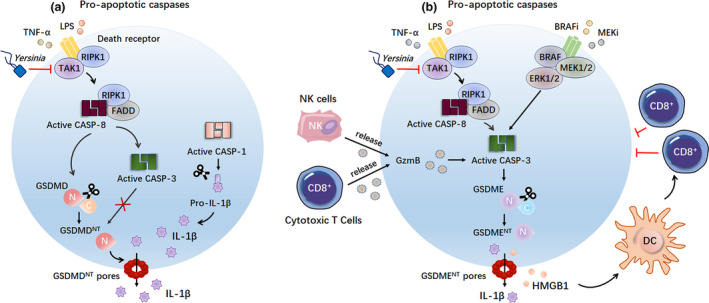Figure 2.

Pro‐apoptotic caspases trigger GSDMDNT‐ and GSDMENT‐mediated pyroptosis. (a) Caspase‐8, activated downstream of Yersinia infection or LPS/TNF‐α/TAK1 inhibitor co‐stimulation, cleaves GSDMD to generate the pyroptotic GSDMDNT domain to trigger pyroptosis. Interestingly, caspase‐3, which is active downstream of caspase‐8 activation, inhibits GSDMDNT‐mediated pyroptosis by counteracting the cleavage of GSDMD. (b) Caspase‐3, which is active downstream of caspase‐8 activation upon Yersinia infection or LPS/TNF‐α/TAK1 inhibitor co‐stimulation, induces GSDME cleavage to trigger GSDME‐dependent pyroptosis in macrophages. In addition, both GzmB from killer cytotoxic lymphocytes and treatment with BRAF inhibitors and MEK inhibitors can induce caspase‐3 activation in cancer cells, finally leading to caspase‐3‐mediated GSDME‐dependent pyroptosis. BRAFi, BRAF kinase inhibitors; CASP‐1, caspase‐1; CASP‐3, caspase‐3; CASP‐8, caspase‐8; DC, dendritic cells; FADD, Fas‐associated protein with death domain; GzmB, granzyme B; HMGB1, high mobility group box 1; MEKi, MEK kinase inhibitors; RIPK1, receptor‐interacting protein kinase 1; TAK1, TGF‐β‐activated kinase 1.
